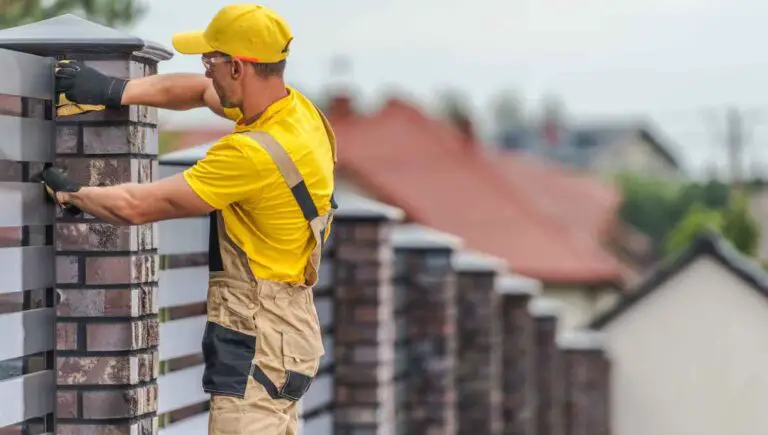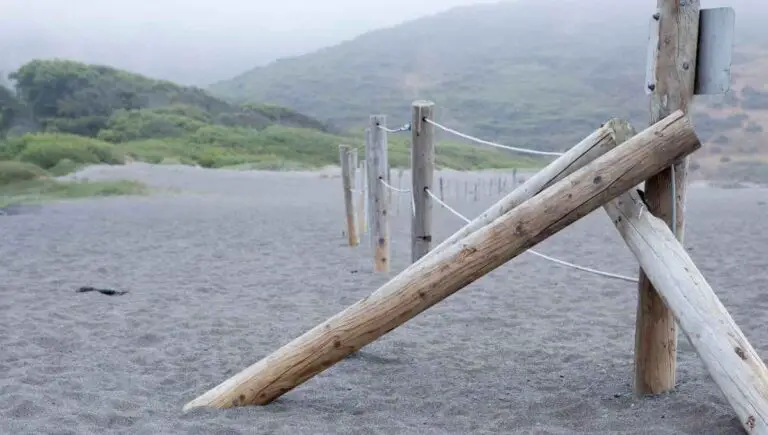Leaning Utility Pole Nearby? (How to Get Them Fixed Quickly)

Leaning utility poles can be dangerous. If they snap, live wires may end up on the ground, maybe even on your property, and that’s a hazard. So, what should you do if you notice a leaning utility pole nearby?
If you notice a leaning utility pole nearby, you should contact the company that owns the utility pole. It’s likely a power line or a telephone line. Report that they have a leaning pole and state that you are concerned it will fall. They should send a worker to assess, fix or replace the pole.
But how do you know for sure what kind of pole it is? Who is ultimately responsible for it? How do they fix these utility poles? We’ve been curious about all these questions and more, so we’re going to find out!
This post contains affiliate links from Amazon and other stores. This means Yard Blogger may earn a commission if you make a purchase using any of our links. Please refer to our full affiliate disclosure policy for full details.
Here’s a Quick Pro Tip!
Having a utility pole leaning nearby may seem dangerous, but as long as you take the proper precautions, it doesn’t have to be.
Try one of these useful ways to block a dangerous pole the next time you see one leaning nearby:
1. Caution Tape – Keep the area blocked off so no one accidentally touches a wire.
2. Warning Cones – Provide an extra warning to keep people and vehicles away.
3. Hazard Banners – Keep drones and humans alike safe!
Strengthen and Brace
To start, we’re discussing what is typically done after you’ve reported a leaning pole. The companies may differ, but the basics of utility pole maintenance remain the same. So, let’s talk about it.
How Far Can a Utility Pole Lean?
Utility poles are always positioned so that they are straight out of the ground. If you notice a leaning utility pole nearby, you’ll want to report it. Any leaning can lead to the pole breaking or falling over.
While a slight lean might not be an immediate danger, it’s still best to report it as soon as possible, so the utility company can have someone come to assess the pole.
If the pole is found to be dangerous, the company will block it off and have it repaired or replaced.
How Do You Fix a Leaning Utility Pole?
A utility company is responsible for fixing its poles. Typically, they will reinforce a leaning utility pole with concrete, or they may replace the pole entirely if the pole has structural damage.
If you notice a leaning utility pole nearby, you should contact the company that owns the pole. You can typically also find a form on their website where you can report a leaning pole.
Or, you can always call their corporate phone number, which will typically be an 800 number in the US.
What Should You Do if a Utility Pole Is Leaning?
If a utility pole is leaning and you think it might fall, or present a present danger, block off the pole without getting too close to it. Refrain from touching the pole. Then, contact the utility company or call 911 if there is an emergency.
The utility company should send a representative to assess the pole and decide whether it needs to be replaced or repaired.
They may pour new concrete to fix the lean or use brackets and braces to hold the pole in place.
How Do You Straighten a Pole in the Ground?
You can straighten a pole in the ground by digging it out and adding extra concrete to reinforce it. You can use brackets and braces if you don’t want to dig. However, if it’s a utility pole, it’s best to leave it to the utility company to fix.
That being said, if the pole is on your property and your responsibility, you have every right to try and straighten it.
You can use an anchor kit to help control the lean of the pole until you can get a professional out to fix it.
How Do You Brace a Power Pole?
Power poles and other utility poles are braced using stakes and ties to anchor them to stable ground. They are also typically encased in concrete, which is then buried to help keep them secure.
Most cities have a standard specification for pole bracing. Having standard specifications means that any worker knows just by looking at the poles whether the lean is too far and if the pole needs to be replaced.
How Do You Straighten a Wooden Pole?
You can straighten a wooden fence post or other small pole using ties and braces, or you can re-establish a strong foundation using concrete and gravel to help brace the pole in place.
While this may not work for utility poles, you can use standard ties on smaller posts to help keep them straight. If those ties don’t work, consider using a tree anchor kit.
They’re designed to keep small trees straight in even the strongest weather conditions.
Fixing or Replacing the Pole
If you see a leaning utility pole nearby, it’s no wonder you’re concerned if your power is about to go out. So now, we’re going to talk about who’s responsible for fixing and replacing those leaning poles.
Who Is Responsible for Replacing a Utility Pole?
The utility company that owns the pole is always responsible for fixing their poles when they become crooked or if they are in poor condition. Therefore, you should not attempt to fix a leaning pole yourself.
The company should routinely send someone to perform inspections and maintenance, but you can also contact them when necessary to come out and check on a leaning pole.
If the pole is down entirely, call 911.
How Long Does a Wooden Utility Pole Last?
Most wooden utility poles are made from preserved wood. Some poles have been up since the early 1900s! These days, wooden utility poles are typically used for up to 50 years, though some have longer lifespans.
Wooden utility poles have such long life spans because the wood is well preserved. While this is helpful while the poles are in use, it also means you must be careful once the pole comes down.
NEVER burn wooden utility poles, as the preservatives are often toxic.
When Should a Utility Pole Be Replaced?
A utility pole should be replaced when it’s leaning, cracked, or otherwise damaged. If you notice damage to a utility pole, report it to the utility company immediately. If the pole is broken, contact 911 to secure the area so no one is harmed.
Utility companies have a standard process for assessing and replacing leaning or damaged utility poles. Therefore, you shouldn’t try to interfere.
At most, you should contact the company if you think a pole is at risk of falling.
How to Report a Leaning Power Pole?
The best and easiest way to report a leaning utility pole nearby, be it a power pole or another type, is to contact the utility company it belongs to. You can use their website or call them directly.
If you get a paper utility bill, they should have a number on the bill that you can call in case of problems with your utilities, including problems with the utility poles.
Otherwise, you can always check the website for a phone number or a form to fill out with potential issues.
Information About Poles
Now that we know who to contact if there is a leaning utility pole nearby let’s discuss other issues with the poles.
After all, even if they’re not your responsibility to care for, it’s still important to know about the potentially dangerous poles close to your property!
Why Do Utility Poles Lean?
Utility poles may start to lean over time due to extreme weather conditions, such as wind. In addition, they may have some base erosion due to cold temperatures eroding the dirt underneath them.
If the utility pole is just starting to lean but isn’t a danger, the utility company may choose to simply brace the pole in order to keep it in place for a while longer.
However, if the lean is severe, they may choose to replace it entirely.
How Deep Are Utility Poles Buried?
Utility poles must be buried at least six feet deep, though it may be even more depending on the height of the pole. It should be buried deep enough to ensure even severe weather won’t make it move.
Because leaning and falling utility poles are such a hazard, utility companies go a long way to ensure that they are placed safely and correctly.
Without these safety standards, the poles may fall during wind storms, and no one wants that!
How Tall Is the Average Power Line Pole?
The height of the standard power line depends on where you’re asking. For example, highway power line poles can be up to 120 feet, whereas the power line poles on your street may only be about 30 feet.
The smallest poles on your walking path are typically only 12 feet, but the poles you are probably thinking of, the ones that are used in almost all cities for utilities, are the standard 30 to 40 feet tall.
What Is the Maximum Distance Between Utility Poles?
Utility poles are typically placed 125 feet (or 38 meters) apart from either other in the city. Whereas, in more rural areas, that distance can be more than doubled, keeping them 300 feet (or 91 meters) apart.
The type of terrain on which the utility poles are placed is one reason for the broad differences in measurements.
If there is no shift in land height, the poles tend to be closer together. The distance also depends on the height of the poles being used.
You might also enjoy our post on Can A Utility Pole Be Moved?
Utility Poles and Your Home
Now that we know quite a lot about utility poles let’s discuss how they may affect you and your home. After all, if you can see a leaning utility pole at or near your house, you need to know what to do about it!
Is It Safe to Live Next to a Leaning Utility Pole?
As long as there are no disconnected live wires, and the pole isn’t damaged, just leaning, it is moderately safe. However, if the pole has a severe lean or you notice it cracking, call 911 immediately.
Otherwise, you are safe to contact the utility company that owns the pole and report an issue with the pole.
They should send a qualified representative out to assess the damages to the pole and either fix the lean or replace the pole entirely, depending on the damages.
Are Electricity Poles Safe?
The wooden poles that hold up live electricity lines are not electric. Therefore, you can touch one without being electrocuted. That being said, they’re still not good to touch.
Utility poles are typically made from preserved wood, and those preservatives can be harmful.
Additionally, the poles do splinter and even rot over time, and messing with them may lead to the pole falling. One last note, NEVER touch electric wires that may have fallen.
What Do You Do if a Utility Pole Is Leaning Close to a House?
If you notice a leaning utility pole nearby and think it may fall on or close to your home, contact the utility company that owns it. They should send a qualified representative out to assess the pole.
If the pole falls, keep back at least ten feet. You may want to use caution tape to warn others if it’s in a public area.
If there are any live wires, stay far away from them, they can electrocute you if they are touched accidentally.
Related Questions
How Do You Preserve a Telephone Pole?
Most telephone poles, as well as other types of utility poles, are preserves using creosote. Using creosote, some utility poles have lasted almost 100 years without needing replacement!
Pentachlorophenol is also a commonly used preservative for utility poles. These strong chemicals are why people are cautioned not to burn utility poles that are no longer in use.
Trust us; you don’t want to breathe in those chemicals!
Why Are There Metal Bands Around the Power Poles?
If you see metal at the bottom of a power pole, you’re most likely seeing part of the brace that is buried with the bottom of the pole. Adding those braces to the ground help prevent the pole from falling during periods of high winds and other severe weather.
You may also notice metal band braces around the middle of the pole, where they are attached to a tie-down. These tie-downs also help anchor the pole to the ground to prevent weather damage.
What Are the Electricity Poles Called?
Electric poles are often just grouped into being called utility poles. Utility poles typically encompass power poles/electricity poles, as well as phone fiber optic cables and even street lights.
Utility poles are broken down into the following three types:
- Tangent distribution poles – The typical wooden poles you see on sidewalks. They usually go in a straight line down a street or highway.
- Guyed distribution poles – These poles require some extra help to keep them in place, hence guy wires.
- Self-supporting distribution poles – Usually made from steel or another strong metal, not wood. Used for transformers.
Final Thoughts
While it may seem scary to have a leaning utility pole nearby, it really doesn’t have to be a huge deal. Contact the utility company that owns the pole and tell them you think it is a hazard.
They should quickly send someone to assess and fix it.










